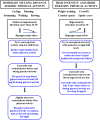Proposed Practical Guidelines to Improve Glycaemic Management by Reducing Glycaemic Variability in People with Type 1 Diabetes Mellitus
- PMID: 40019699
- PMCID: PMC11926304
- DOI: 10.1007/s13300-025-01703-0
Proposed Practical Guidelines to Improve Glycaemic Management by Reducing Glycaemic Variability in People with Type 1 Diabetes Mellitus
Abstract
Introduction: For decades, glycaemic variability (GV) was ignored in clinical practice because its precise assessment was challenging and there were no specific recommendations to reduce it. However, the current widespread use of continuous glucose monitoring (CGM) systems has changed this situation. Associations between high GV and risk of hypoglycaemia, onset of macro- and microvascular complications and mortality have been described in type 1 diabetes (T1D). It is therefore important to identify the causes of excessive glycaemic excursions and make recommendations for people with T1D to achieve better glycaemic management by minimising GV in both the short term and the long term.
Methods: To achieve these aims, a panel comprising four endocrinologists, one diabetes nurse educator and one nutritionist worked together to reach a consensus on the detection of triggers of GV and propose clinical guidelines to reduce GV and improve glycaemic management by reducing the risk of hypoglycaemias.
Results and conclusions: In total, four different areas of interest were identified, in which the insufficient education and/or training of people with T1D could lead to higher GV: physical activity; dietary habits; insulin therapy, especially when pump-based systems are not used; and other causes of GV increase. Practical, easy-to-follow recommendations to reduce GV in daily activities were then issued, with the aim of enabling people with T1D to reduce either hypoglycaemia or hyperglycaemia episodes. By doing this, their quality of life may be improved, and progression of chronic complications may be prevented or delayed.
Keywords: Diet; Glycaemic variability; Hypoglycaemia; Insulin; Physical activity; Proposed guidelines; Type 1 diabetes.
© 2025. The Author(s).
Conflict of interest statement
Declarations. Conflict of Interest: Alejandra de Torres has the following financial relationships: lectures for Novo Nordisk, received grant support from Abbott and research activities from Novo Nordisk and Eli Lilly and Company. Francisco Javier Ampudia-Blasco has served as a consultant/advisor for Abbott Diabetes Care, AstraZeneca, Boehringer Ingelheim, Eli Lilly, GlaxoSmithKline, LifeScan, MannKind Co., Medtronic, Menarini, Merck, Novartis, Novo Nordisk and Sanofi; as a speaker for Abbott Diabetes Care, AstraZeneca, Boehringer Ingelheim, GlaxoSmithKline, LifeScan, Eli Lilly, Madaus, Medtronic, Menarini, Merck, Novartis, Novo Nordisk and Sanofi; and has received grant support from Novo Nordisk and Sanofi. Virginia Bellido received consulting fees from Abbott, Eli Lilly, Novo Nordisk and Sanofi; received honoraria from Abbott, Astra Zeneca, Boehringer Ingelheim, Esteve, Eli Lilly, MSD, Mundipharma, Novo Nordisk and Sanofi; and received support to attend meetings from Abbott, Astra Zeneca, Boehringer Ingelheim, Esteve, Eli Lilly, MSD, Novo Nordisk and Sanofi. Antonio J. Amor has the following financial relationships: speaker for Novo Nordisk, Lilly, Sanofi and MSD. Pedro Mezquita-Raya has the following financial relationships: advisor on scientific boards for Abbott, Astra-Zeneca, FAES and Novo Nordisk; lectures for Astra-Zeneca, Eli Lilly and Company, FAES, Fresenius and Novo Nordisk; and research activities for Eli Lilly and Company and Novo Nordisk. Serafín Murillo declares that he has no competing interests. Antonio J. Amor is an Editorial Board member of Diabetes Therapy. Antonio J. Amor was not involved in the selection of peer reviewers for the manuscript nor any of the subsequent editorial decisions. Ethical Approval: This article is based on previously conducted studies as well as on previous authors’ observations and does not contain any new studies with human participants or animals performed by any of the authors. Springer Healthcare’s Disclosure: Springer Healthcare is not responsible for the validity of the guidelines it publishes.
Figures
References
-
- Gomes da Costa C, Matos T, Vale S. Association between the coefficient of glycemic variation and time in range, below and above range in continuous monitoring glucose systems in type 1 diabetes. Endocr Abstr. 2022;81:P325.
-
- Rodbard D. Glucose variability: a review of clinical applications and research developments. Diabetes Technol Ther. 2018;20:S25-215. - PubMed
Publication types
LinkOut - more resources
Full Text Sources


